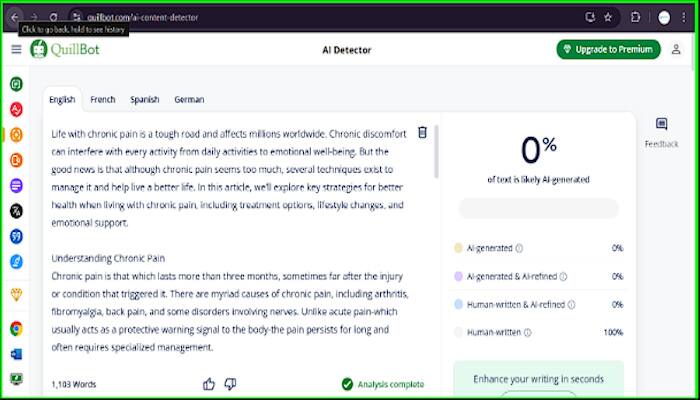There are myriad causes of chronic pain, including arthritis, fibromyalgia, back pain, and some disorders involving nerves.
Life with chronic pain is a tough road and affects millions worldwide. Chronic discomfort can interfere with every activity from daily activities to emotional well-being. But the good news is that although chronic pain seems too much, several techniques exist to manage it, including treatments like oxalgin dp tablet, and help live a better life. In this article, we’ll explore key strategies for better health when living with chronic pain, including treatment options, lifestyle changes, and emotional support.

Understanding Chronic Pain
Chronic pain is that which lasts more than three months, sometimes far after the injury or condition that triggered it. There are myriad causes of chronic pain, including arthritis, fibromyalgia, back pain, and some disorders involving nerves. Unlike acute pain-which usually acts as a protective warning signal to the body-the pain persists for long and often requires specialized management.
Chief Management Approaches for Chronic Pain
1. Medical Doctor Consultation
First and foremost, dealing with chronic pain requires one to seek consultation with a medical doctor. This professional will aid in ascertaining the origin of the pain thus aid in the selection of the appropriate treatment mode and management plan. The medical professional may provide drugs or suggest some physical therapy for patients, among others, based on the kind of pain being suffered by a patient.
Among the available interventions for managing chronic pain, drugs are quite central. There are several other musculoskeletal conditions for which they are administered to treat for which Oxalgin Dp tablet is one of the most preferred pain relief medications. Its main action mechanism surrounds inflammation reduction along with the abatement of uncomfortable sensations. Again, its consumption would depend strictly on the discretion of the physicians so that bad effects or a tendency towards some sort of addiction do not get set in.
In addition to analgesics, other drugs including Fevanux Tablet may be provided. This drug is very effective when the pain involves inflammation or spasms of muscles. It relieves both pain and symptoms making it a much more holistic therapy for chronic pain.
2. Physical Therapy and Exercise
The involvement of physical therapy in the treatment plan is beneficial for people with chronic pain conditions. A physical therapist can assist you in exercise to make you more limber, stronger, and preserve proper posture. This may minimize your pain and, often, even avert the worsening of the condition over time. In some cases, specific exercises are done to focus on the muscles or the joints that are nearest in approximation to the condition causing the pain.
Swimming, walking, or even some types of yoga may be very useful for a patient with chronic pain. Such activities improve the strengthening of muscles and joints' movement and also relieve the stress caused on the body. The goal is to exercise regularly in the management of chronic pain in the long term.
3. Mind-Body Techniques
Chronic pain has devastating effects on the mental health of most patients. Thus, they get frustrated, anxious, and may even experience a depression phase in their lives. Therefore, one should integrate mind-body techniques for the treatment of emotional and psychological aspects of pain.
Meditation, deep breathing, and mindfulness techniques help people manage the psychological tension and stress caused by chronic pain. They are helpful as they make a person focus on the present, decrease stress levels, and enable building a sense of relaxation.
Other interventions include cognitive behavioral therapy (CBT). CBT can aid in changing the way of thinking by reframing negative thought patterns and teaching coping skills for better management of pain. This also takes care of the emotional issues involved with chronic pain, which could make a huge difference in quality of life.
4. Healthy Eating and Nutrition
Consuming a well-balanced diet helps in reducing chronic pain. Foods that contain omega-3 fatty acids, antioxidants, and vitamins have anti-inflammatory effects that can help in the mitigation and reduction of inflammatory responses in the case of pain. Fish, nuts, berries, and leafy green vegetables are good to add to your diet.
There are also foods to avoid: such as processed foods, too much sugar, and trans fats. A diet high in whole, unprocessed foods will support the body's own pain management system and help avoid flare-ups.
More importantly, people with chronic pain need to have a healthy weight. The added weight upon the musculoskeletal and the joints can further compound pain, especially in cases of arthritis. Therefore, a good diet that balances these together with regular physical activity can be highly effective in reducing pain and in general improving health.
5. Sleep and Rest
Sleep time is essential in the management of pain. In the absence of good sleep, conditions worsen such that a vicious circle of pain becomes an element. Establish a regular sleep pattern and make it conducive for a restful sleep. Aim to get 7-9 hours of sleep every night. Avoid activities that can disturb sleep, including excessive screen time and caffeine intake before bed.
If it is interfering with your sleep, discuss this further with your physician. Some pain drugs, such as Oxalgin, can help you sleep through pain, at least part of the night.
6. Support and Social Connections
People who suffer from chronic pain often feel isolated and alone. It's important to find support among family, friends, or in online forums where you can share your experiences with others and take comfort in knowing that others are doing the same. Social support is important in regards to alleviating mental health issues as well as the emotional strain that develops with chronic pain.
A good way to share tips, coping mechanisms, and personal experiences for chronic pain can be support groups. It may also help in learning how other people cope with their pain and what works for them.
7. Alternative Therapies
Besides these routine treatments, there are some supplementary therapies that help in reducing chronic pain. Some of the examples include acupuncture, massage therapy, and chiropractic treatment, which were said to have helped for some. These forms of therapy attack specific locations in the body that cause the pain and allow balance in the body once more.
It is essential to discuss any alternative treatments with your doctor to ensure they complement your existing treatment plan. They may also offer insight into which therapies are most effective for your specific condition.
Conclusion
Living with chronic pain is certainly not easy, but with the right approach, it is possible to manage the pain and lead a fulfilling life. You can improve your quality of life by consulting healthcare professionals, incorporating physical therapy, using medications like Oxalgin dp tablet and fevanux tablet, focusing on emotional well-being, and making positive lifestyle changes.

